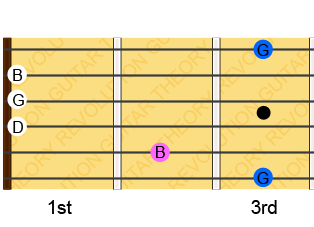
This lesson will show you a selection of basic guitar chords for beginners. These diagrams will show you the chords C, A, G, E and D as well as two Major bar-chords (moveable chords where the index finger forms an artificial bar across all the strings). Each guitar chord diagram shows you which notes to play on each string and a suggestion will be given on which fingers to use. The note names in coloured circles are where you put your fingers, those in white circles are strings that are played but not fretted while the strings marked with an X should be muted or not played.
If you are a beginner you should be careful with the bar chords since they require you to stretch your fingers and hand in a way that might be uncomfortable at first. Take things slowly and stop if you experience any pain. If you practice these chord shapes for just a few minutes a day you’ll quickly find your hands becoming stronger and more flexible.
Remember that I number the guitar strings in a different way than most people (low E, 1 to high E, 6). Your fingers are numbered as followed: index finger = 1, middle finger = 2, ring finger = 3 and little finger = 4.
C Major Chord
For this chord you should place your 1st (index) finger on the C of the 5th string, your 2nd (middle) finger on the E on the 3rd string and your 3rd (ring) finger on the C on the 2nd string. The 1st strong (Low E) is usually not played or muted.


A Major Chord
The 1st finger holds the E on the 3rd string, the 2nd is on the A on the 4th string and the 3rd holds the C# on the 5th string.


G Major Chord
The 2nd finger frets the G on the 1st string, the 2nd finger holds the B on the 2nd string. Strings G, B and E are left open and the G on the 6th string is fretted with your 4th finger. Some people hold down the D on the 5th string with their 3rd finger as well as this helps them switch between the G and D more easily.


E Major Chord
The 1st finger on the G# on the 4th string, 2nd finger on the B on the 2nd string and 3rd finger on the E of the 3rd string.


D Major Chord
There are two common ways to play this chord. The first is to place finger 1 on the A on the 4th string, finger 3 on the D on the 5th string and finger 2 on the F# on the 6th string. You can either mute the 1st string or fret it at the F# with your thumb.
Another way to play this chord is with your 2nd finger on the A, 3rd on the F# and 4th on the D. It is worth practicing this way of holding the chord as it will help you later on when you play barred versions of this D-shape.


Bar Chords
Bar chords are chords where you hold down all strings across the neck with your index finger and use your other fingers to hold a chord. Think of it as using your finger as a capo.
This chord may be a bit hard to hold if you are a beginner. Don’t push yourself too hard as you might cause excessive strain in your hand and wrist. You can always come back to this chord at a later time.
The 1st finger holds the A on the 1st string, 3rd finger holds the E on the 2nd string, the 4th finger holds the A on the 3 string and the 2nd finger holds the C# on the 4th string. If you can, try holding your first finger down across all the strings so that you fret the top two strings A and A as well. This chord shape is commonly used to hold the F Major chord. All you need to do is slide this shape down to the first fret.


This chord may also be a bit hard to hold if you are a beginner. But there are several ways you can play this chord so choose one that is most comfortable for you. Remember you can always come back to this chord at a later time after you’ve developed more hand strength and can stretch your fingers more comfortably.
The most difficult way to hold this chord, but the one that will give you the most flexibility in the future is to place your 1st finger across all the frets at the 5th fret. Then place your 2nd, 3rd and 4th fingers on the A, D and F# notes on the 3rd, 4th and 5th strings.
The 2nd way is to mute or not hold the notes on the 1st and 6th strings and only play the central 4 strings. This way you only have to hold one note with your 1st string.
The final way is to hold the D on the 2nd string with your 1st finger as before but this time to use your 3rd finger to hold down all the notes on the 3rd, 4th and 5th strings. This is how many rock, punk and metal players hold down the chord (often leaving out the note on the 5th string as well). This may be the way you first hold this chord shape, but you might find it limiting your ability later on and you’ll want to try the other ways when you are ready. This shape is a common way to play the B Major chord, just play this shape at the 2nd fret.


